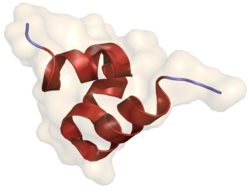Osteocalcin, also known as bone gamma-carboxyglutamic acid-containing protein (BGLAP), is a small (49-amino-acid[5]) noncollagenous protein hormone found in bone and dentin, first identified as a calcium-binding protein.[6]
Because osteocalcin has gla domains, its synthesis is vitamin K-dependent. In humans, osteocalcin is encoded by the BGLAP gene.[7][8] Its receptors include GPRC6A, GPR158, and possibly a third, yet-to-be-identified receptor.[9][10] There is evidence that GPR37 might be the third osteocalcin receptor.[11]
- ^ a b c GRCh38: Ensembl release 89: ENSG00000242252 – Ensembl, May 2017
- ^ a b c GRCm38: Ensembl release 89: ENSMUSG00000074489 – Ensembl, May 2017
- ^ "Human PubMed Reference:". National Center for Biotechnology Information, U.S. National Library of Medicine.
- ^ "Mouse PubMed Reference:". National Center for Biotechnology Information, U.S. National Library of Medicine.
- ^ Hauschka PV, Carr SA, Biemann K (February 1982). "Primary structure of monkey osteocalcin". Biochemistry. 21 (4): 638–642. doi:10.1021/bi00533a006. PMID 6978733.
- ^ Hauschka PV, Reid ML (August 1978). "Timed appearance of a calcium-binding protein containing gamma-carboxyglutamic acid in developing chick bone". Developmental Biology. 65 (2): 426–434. doi:10.1016/0012-1606(78)90038-6. PMID 680371.
- ^ Puchacz E, Lian JB, Stein GS, Wozney J, Huebner K, Croce C (May 1989). "Chromosomal localization of the human osteocalcin gene". Endocrinology. 124 (5): 2648–50. doi:10.1210/endo-124-5-2648. PMID 2785029.
- ^ Cancela L, Hsieh CL, Francke U, Price PA (September 1990). "Molecular structure, chromosome assignment, and promoter organization of the human matrix Gla protein gene". The Journal of Biological Chemistry. 265 (25): 15040–8. doi:10.1016/S0021-9258(18)77221-9. PMID 2394711.
- ^ Pi M, Wu Y, Quarles LD (July 2011). "GPRC6A mediates responses to osteocalcin in β-cells in vitro and pancreas in vivo". Journal of Bone and Mineral Research. 26 (7): 1680–3. doi:10.1002/jbmr.390. PMC 5079536. PMID 21425331.
- ^ Berger JM, Singh P, Khrimian L, Morgan DA, Chowdhury S, Arteaga-Solis E, et al. (September 2019). "Mediation of the Acute Stress Response by the Skeleton". Cell Metabolism. 30 (5): 890–902.e8. doi:10.1016/j.cmet.2019.08.012. PMC 6834912. PMID 31523009.
- ^ Qian Z, Li H, Yang H, Yang Q, Lu Z, Wang L, et al. (October 2021). "Osteocalcin attenuates oligodendrocyte differentiation and myelination via GPR37 signaling in the mouse brain". Science Advances. 7 (43): eabi5811. Bibcode:2021SciA....7.5811Q. doi:10.1126/sciadv.abi5811. PMC 8535816. PMID 34678058.




